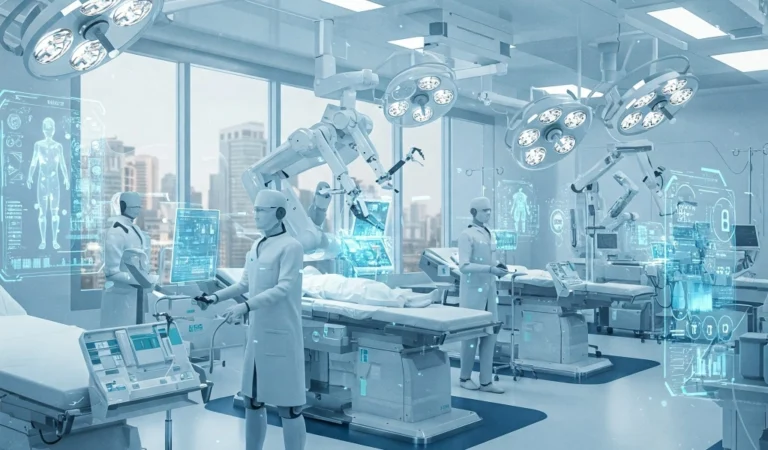The healthcare industry is on the brink of a technological revolution, and artificial intelligence (AI) is leading the charge. From predicting deadly diseases before symptoms appear to robot-assisted surgeries with superhuman precision, AI is set to save millions of lives and reduce medical costs in ways previously unimaginable.
By 2030, experts predict that:
✔ AI could reduce diagnostic errors by 30% (NIH)
✔ Robotic surgeons will assist in 90% of complex operations (McKinsey)
✔ Virtual nurses will handle 50% of patient interactions (Accenture)
In this in-depth guide, we’ll explore 10 revolutionary AI applications in healthcare, real-world examples, ethical concerns, and what the future holds.
1. Early Disease Detection with AI Diagnostics
One of AI’s most life-saving applications is its ability to spot diseases at their earliest stages—often before symptoms emerge.
How It Works:
- AI analyzes medical imaging (X-rays, MRIs), genetic data, and electronic health records (EHRs).
- Machine learning models detect hidden patterns that human doctors might miss.
Real-World Examples:
🔹 Google DeepMind’s AI detects breast cancer in mammograms more accurately than radiologists (Nature, 2020).
🔹 IBM Watson for Oncology helps diagnose rare cancers with 93% accuracy.
🔹 Cardiogram’s AI predicts atrial fibrillation (AFib) 30 minutes before it happens using smartwatch data.
Future Impact:
- By 2027, AI diagnostics could prevent 20% of late-stage cancer deaths through early detection.
2. AI-Powered Robotic Surgery
Robotic surgeons, guided by AI, are making procedures safer, faster, and minimally invasive.
How It Works:
- AI assists human surgeons with real-time data, precision tools, and tremor reduction.
- Some systems, like autonomous surgical robots, can perform tasks without human intervention.
Real-World Examples:
🔹 Da Vinci Surgical System – Used in 500,000+ surgeries/year with fewer complications.
🔹 Smart Tissue Autonomous Robot (STAR) – Performed better than human surgeons in soft-tissue operations (Science Robotics).
Future Impact:
- By 2030, AI-assisted robots may conduct fully autonomous emergency surgeries in remote areas.
3. AI Virtual Nurses & Chatbots for 24/7 Care
AI-powered virtual nurses and chatbots provide instant medical advice, reducing hospital visits.
How It Works:
- Chatbots (like Ada, Buoy Health) ask patients about symptoms and recommend treatments.
- AI virtual assistants (like Sensely) monitor chronic conditions via wearables.
Real-World Examples:
🔹 Babylon Health’s AI doctor handles millions of consultations/year with 92% patient satisfaction.
🔹 Woebot (AI therapy chatbot) reduces depression and anxiety symptoms in clinical trials.
Future Impact:
- 50% of routine doctor visits could be replaced by AI by 2027, cutting healthcare costs.
4. Drug Discovery & AI-Designed Medicines
AI is speeding up drug development—from 10 years to just 12 months in some cases.
How It Works:
- AI models (like AlphaFold) predict protein structures to design new drugs.
- Machine learning analyzes millions of chemical compounds to find potential cures.
Real-World Examples:
🔹 Insilico Medicine used AI to discover a new fibrosis drug in just 18 months (vs. 5+ years traditionally).
🔹 BenevolentAI identified baricitinib as a COVID-19 treatment before human researchers.
Future Impact:
- By 2030, 50% of new drugs could be AI-discovered, saving billions in R&D costs.
5. AI for Personalized Medicine & Genomics
AI tailors treatments based on a patient’s DNA, lifestyle, and medical history.
How It Works:
- AI analyzes genomic data to predict disease risks.
- Recommends customized treatment plans for cancer, diabetes, and rare diseases.
Real-World Examples:
🔹 Tempus AI helps oncologists design personalized cancer therapies.
🔹 23andMe + Google AI predict Parkinson’s disease risk from genetic data.
Future Impact:
- “Precision medicine” could replace one-size-fits-all treatments by 2030.
6. AI in Mental Health: Therapy & Suicide Prevention
AI chatbots and algorithms are detecting depression, anxiety, and suicide risks early.
How It Works:
- NLP (Natural Language Processing) analyzes speech patterns for mental health risks.
- AI chatbots (like Woebot, Wysa) provide CBT-based therapy.
Real-World Examples:
🔹 Facebook’s AI detects suicidal posts and alerts responders.
🔹 Ellie (USC’s AI therapist) identifies PTSD in veterans with 90% accuracy.
Future Impact:
- AI could reduce global suicide rates by 20% through early detection.
7. AI-Powered Wearables for Real-Time Health Monitoring
Smartwatches and implants now predict heart attacks, seizures, and diabetic emergencies.
How It Works:
- AI analyzes heart rate, blood oxygen, and activity data to detect anomalies.
Real-World Examples:
🔹 Apple Watch ECG detects AFib with 98% accuracy.
🔹 Dexcom G7 predicts diabetic episodes 20 minutes in advance.
Future Impact:
- By 2025, 1 in 5 adults may rely on AI wearables for chronic disease management.
8. AI for Hospital Workflow & Administrative Automation
AI is cutting admin costs, reducing wait times, and optimizing staff schedules.
How It Works:
- AI automates appointment scheduling, billing, and insurance claims.
- Predictive analytics forecasts patient admissions.
Real-World Examples:
🔹 Johns Hopkins’ AI system reduced ER wait times by 30%.
🔹 Olive AI automates $50B/year in healthcare paperwork.
Future Impact:
- AI could save U.S. hospitals $150B annually by 2030.
9. AI in Pandemic Prediction & Outbreak Control
AI models predicted COVID-19’s spread—future systems could stop outbreaks before they start.
How It Works:
- AI scans news reports, flight data, and lab results to detect outbreaks.
Real-World Examples:
🔹 BlueDot AI warned of COVID-19 9 days before WHO.
🔹 Metabiota predicts disease hotspots using climate and travel data.
Future Impact:
- AI could prevent the next pandemic by detecting viruses in real time.
10. AI and Brain-Computer Interfaces (BCIs)
Elon Musk’s Neuralink and other BCIs could cure paralysis, blindness, and depression.
How It Works:
- AI decodes brain signals to control prosthetics or restore vision.
Real-World Examples:
🔹 Neuralink’s first human trial lets a paralyzed man play chess with his mind.
🔹 Synchron’s BCI enables texting via thought.
Future Impact:
- By 2035, BCIs could reverse paralysis and treat Alzheimer’s.
Ethical Concerns & Challenges
While AI in healthcare has massive potential, key risks include:
Data Privacy – Who owns patient data?
AI Bias – Can algorithms discriminate?
Job Displacement – Will AI replace doctors?
Conclusion: The Future of AI in Healthcare
AI is not just improving healthcare—it’s reinventing it. From early disease detection to robot-assisted surgeries, the possibilities are endless.
What’s Next?
- By 2025: AI diagnostics become standard in hospitals.
- By 2030: Fully autonomous AI doctors may emerge.
What do you think? Will AI make healthcare better—or riskier? Share your thoughts below!


